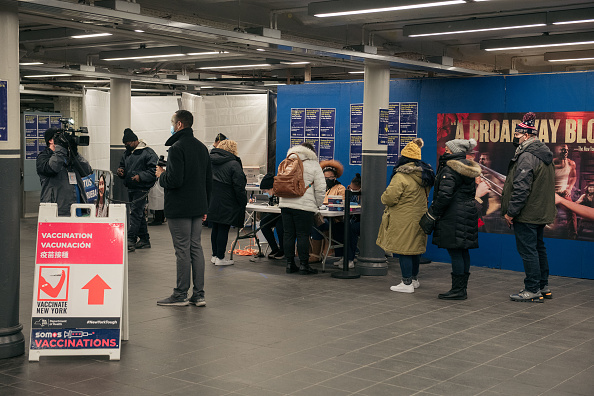The Biden administration has ramped up COVID-19 testing and the plan was announced when typically more than 100 million Americans were about to begin holiday travel.
Low or no-cost testing was available at local health centers and pharmacies nationwide throughout the fall. Massachusetts, New Hampshire, New Jersey, and Washington already had a free at-home test program in place by December. However, rapid tests cost $25 and were in short supply.
Then, on December 21, as public health officials issued more dire warnings about the new Omicron variant, the White House announced it would start delivering up to 500 million free, at-home COVID-19 rapid tests to anyone who wanted one.
More Testing, More Positive Results
As more Americans access free or low-cost tests, more people test positive for COVID-19. Cases started soaring about the second week in December.
Positive cases caused havoc in the nation’s airports. Some 2,300 flights were canceled over the Christmas weekend, thousands more were delayed or canceled around the globe, and 1,200 more flights were canceled due to crew members calling in sick, the New York Post reported on December 27, the Monday after Christmas.
Testing positive has a domino effect on activity because individuals who test positive inform others, who then feel compelled, sick or not, to get tested or stay home.
Official Testing Advice
The Centers for Disease Control and Prevention (CDC) offers broad guidance regarding who should get tested.
On its website, the CDC recommends testing for people who have symptoms of COVID-19, people who have come into “close contact with someone with COVID-19,” immediate testing for individuals not fully vaccinated who have been in “close contact,” and people not fully vaccinated who have been asked or referred to get testing by a school, workplace, or health care provider.
The website encourages people who “are sick with COVID-19” or “think [they] might have COVID-19,” to stay home, separate from others, and tell all close contacts of a possible infection.
Cold Symptoms?
The CDC says symptoms of COVID-19 can include any of the following: fever or chills, cough, shortness of breath or difficulty breathing, fatigue, muscle or body aches, headaches, loss of taste or smell, sore throat, congestion or runny nose, nausea or vomiting, or diarrhea.
Many of these symptoms resemble the common cold and are not uncommon during the winter months when people are mostly indoors and in close contact with others. The CDC admits it is still trying to learn more about the Omicron variant of COVID-19.
“More data are needed to know if Omicron infections, and especially reinfections and breakthrough infections in people who are fully vaccinated, cause more severe illness or death than infection with other variants,” states the agency’s website. It recommends vaccines, masks, and testing.
Widespread Testing ‘Makes No Sense’
Testing broad swaths of the general public for a wide variety of common symptoms is begging for trouble, says Jeffrey Singer, M.D., a senior fellow at the Cato Institute.
“It makes no sense to test everyone, symptomatic or otherwise, high-risk or otherwise, considering the large percentage of the population that at this point has a fair amount of immunity,” said Singer.
“We will wind up unnecessarily shuttering much of society,” said Singer. “Test the symptomatic and test those who work with vulnerable people, such as nursing home workers, hospital workers, and caregivers. We need focused testing along with focused protection if we ever hope to live in a world with endemic COVID.”
Test Until Positive
Massive public testing can create all kinds of data distortions, says Erwin Haas, M.D., an infectious disease expert and policy advisor to The Heartland Institute, which co-publishes Health Care News. “[The statistician Thomas] Bayes would have scoffed,” said Haas.
Haas says several members of his family had symptoms resembling the common cold. The family had PCR tests; three of four were negative. “My question about which tests are truly negative, and which are positive, has been ignored,” said Haas.
The issue then becomes who should be retested, says Haas. “The point of testing seems to be to continue testing until the individual gets a positive, not to manage the disease,” said Haas. “It’s more of a fashion statement.”
As a virus mutates, it often becomes more easily transmitted, but milder in its effects, says Haas. “The omicron variant does not seem to be that serious and, if very contagious, a classical off-ramp for epidemic infections,” said Haas.
AnneMarie Schieber (amschieber@heartland.org) is the managing editor of Health Care News.





















